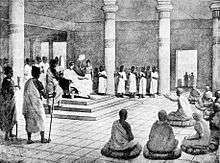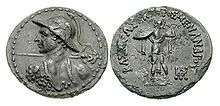Milinda Panha

The Milinda Panha (Pali trans. "Questions of Milinda") is a Buddhist text which dates from approximately 100 BCE. It is included in the Burmese edition of the Pāli Canon of Theravada Buddhism as a book of the Khuddaka Nikaya; however, it does not appear in the Thai or Sri Lankan versions. A shorter version of it, however, is featured in Chinese Mahayana translations.
It purports to record a dialogue in which the Indo-Greek king Menander I (Pali Milinda) of Bactria, who reigned in the 2nd century BCE, poses questions on Buddhism to the sage Nāgasena.
History
| Part of a series on |
| Theravāda Buddhism |
|---|
 |
| Pāli Canon |
|---|
| Vinaya Pitaka |
| Sutta Pitaka |
| Abhidhamma Pitaka |
The earliest part of the text is believed to have been written between 100 BCE and 200 CE.[1] The text may have initially been written in Sanskrit;[2] however, apart from the Sri Lankan Pali edition and its derivatives, no other copies are known.
It is generally accepted by scholars[3] that the work is composite, with additions made over some time. In support of this, it is noted that the Chinese versions of the work are substantially shorter.[4]
The oldest manuscript of the Pali text was copied in 1495 CE. Based on references within the text itself, significant sections of the text are lost, making Milinda the only Pali text known to have been passed down as incomplete.[5]
The book is included in the inscriptions of the Canon approved by the Burmese Fifth Council and the printed edition of the Sixth Council text.
Rhys Davids says it is the greatest work of classical Indian prose,[6] though Moritz Winternitz says this is true only of the earlier parts.[7]
Contents
The contents of the Milindapañhā are:
- Background History
- Questions on Distinguishing Characteristics : (Characteristics of Attention and Wisdom, Characteristic of Wisdom, Characteristic of Contact, Characteristic of Feeling, Characteristic of Perception, Characteristic of Volition, Characteristic of Consciousness, Characteristic of Applied Thought, Characteristic of Sustained Thought, etc.)
- Questions for the Cutting Off of Perplexity : (Transmigration and Rebirth, The Soul, Non-Release From Evil Deeds, Simultaneous Arising in Different Places, Doing Evil Knowingly and Unknowingly, etc.)
- Questions on Dilemmas : Speaks of several puzzles and these puzzles were distributed in eighty-two dilemmas.
- A Question Solved By Inference
- Discusses the Special Qualities of Asceticism
- Questions on Talk of Similes
According to Oskar von Hinüber (2000), while King Menander is an actual historical figure, Bhikkhu Nagasena is otherwise unknown, the text includes anachronisms, and the dialogue lacks any sign of Greek influence but instead is traceable to the Upanisads.[8]
The text mentions Nāgasena's father Soñuttara, his teachers Rohana, Assagutta of Vattaniya and Dhammarakkhita of Asoka Ārāma near Pātaliputta, and another teacher named Āyupāla from Sankheyya near Sāgala.
Translations

The work has been translated into English twice, once in 1890 by Thomas William Rhys Davids (reprinted by Dover Publications in 1963) and once in 1969 by Isaline Blew Horner (reprinted in 1990 by the Pali Text Society).
- Questions of King Milinda, tr T. W. Rhys Davids, Sacred Books of the East, volumes XXXV & XXXVI, Clarendon/Oxford, 1890–94; reprinted by Motilal Banarsidass, Delhi Vol. 1, Vol. 2
- Milinda's Questions, tr I. B. Horner, 1963-4, 2 volumes, Pali Text Society, Bristol
Abridgements include:
- Pesala, Bhikkhu (ed.), The Debate of King Milinda: An Abridgement of the Milindapanha. Delhi: Motilal Banarsidass, 1992. Based on Rhys Davids (1890, 1894).
- Mendis, N.K.G. (ed.), The Questions of King Milinda: An Abridgement of the Milindapanha. Kandy, Sri Lanka: Buddhist Publication Society, 1993 (repr. 2001). Based on Horner (1963–64).
See also
Notes
- ↑ Hinuber (2000), pp. 85-6, para. 179.
- ↑ Hinüber (2000), p. 83, para. 173, suggests, based on an extant Chinese translation of Mil as well as some unique conceptulizations within the text, the text's original language might have been Gandhari.
- ↑ Hinüber (2000), pp. 83-86, para. 173-179.
- ↑ According to Hinüber (2000), p. 83, para. 173, the first Chinese translation is believed to date from the 3rd century and is currently lost; a second Chinese translation, known as "Nagasena-bhiksu-sutra," (那先比丘經) dates from the 4th century. The extant second translation is "much shorter" than that of the current Pali-language Mil.
- ↑ Hinuber (2000), p. 85, para. 178.
- ↑ Rhys Davids (1890, 1894), p. xlviii, writes: "[T]he 'Questions of Milinda' is undoubtedly the masterpiece of Indian prose, and indeed is the best book of its class, from a literary point of view, that had then been produced in any country."
- ↑ History of Indian Literature
- ↑ von Hinuber (2000), p. 83, para. 172.
Sources
- Hinüber, Oskar von (1996/2000). A Handbook of Pāli Literature. Berlin: Walter de Gruyter. ISBN 3-11-016738-7.
- Winternitz, Moritz. History of Indian Literature.
External links
- The Questions of King Milinda, translated by Thomas William Rhys Davids. at Sacred-texts.com.
- The Debate of King Milinda, Most Recent HTML and PDF Editions.
- The Debate of King Milinda, Abridged Edition. Bhikkhu Pesala. Hosted at BuddhaNet.
- Milindapañha - Selected passages in both Pali and English, translated by John Kelly
- Milinda Panha Sinhalese translation